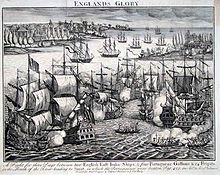Battle of Suvali
| Battle of Swally (Suvali) | |||||||
|---|---|---|---|---|---|---|---|
| Part of the Tenth English voyage to India | |||||||
 Eighteenth-century engraving showing the battle of Swally delivered on 9-10 December 1612 between ships of the Bristish East India Company and the Portuguese Navy |
|||||||
|
|||||||
| Belligerents | |||||||
|
|
|||||||
| Commanders and leaders | |||||||
| Captain Thomas Best | Unknown | ||||||
| Strength | |||||||
| Four galleons | Four naus, 26 barques | ||||||
The naval Battle of Swally, also known as Battle of Suvali, took place on 29–30 November 1612 off the coast of Suvali (anglicised to Swally) a village near the Surat city (now in Gujarat, India) and was a victory for four English East India Company galleons over four Portuguese naus and 26 barks (rowing vessels with no armament).
This relatively small naval battle is historically important as it marked the beginning of the end of Portugal's commercial monopoly over India, and the beginning of the ascent of the English East India Company's presence in India.
This battle also convinced the English East India Company to establish a small navy to safeguard their commercial interests from other European powers and also from pirates. This small beginning is regarded as the root of the modern Indian Navy.
The background to this battle also points to the main reason for the Dutch Vereenigde Oostindische Compagnie being organised in 1602.
This battle was the result of the Portuguese monopoly over trade with India in the late-15th and 16th centuries. Two English ventures, The Company of Merchant Adventurers (established 1551) which became the Muscovy Company in 1555, and the English East India Company also known as "John Company", (established 1600) were desperately attempting to find routes to the East Indies and the spice trade. The following three individuals played a key part in the events leading up to this battle:
...
Wikipedia
